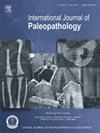在费城历史上第一浸信会墓地发现的一名青少年男性疑似恶性肿瘤(1722-1859,美国)。
IF 1.5
3区 地球科学
Q3 PALEONTOLOGY
引用次数: 0
摘要
目的:评估一套病变的骨骼遗骸从历史费城青少年。材料:在费城第一浸信会教堂(1722-1859)的历史墓地中,由于施工的干扰,这具保存完好的骨架被挖掘出来。方法:使用低倍放大辅助的宏观视觉评估来识别和描述病变。进行了鉴别诊断,考虑了埋藏和多种可能的疾病类别。结果:个体为15-19岁男性。在整个中轴骨骼以及左肩胛骨和指骨处观察到主要溶骨和混合性溶骨/成骨病变的组合。结论:病变的分布和形态特征与累及造血骨髓的恶性肿瘤高度一致。意义:这一可能的病例为广泛的北美儿童和青少年癌症的古病理学证据提供了补充,特别是在18至19世纪大西洋中部。结果的背景化提供了历史悠久的费城癌症经验的更广泛的理解。局限性:病变检查局限于宏观视觉分析。结合放射学技术可以观察到额外的特征,并可能缩小病理过程的诊断选择。进一步研究建议:该患者的病变特征与几种恶性肿瘤重叠。该病例研究强调,古病理学家在肿瘤疾病的鉴别诊断中应继续保持谨慎,特别是在依赖视觉分析时。本文章由计算机程序翻译,如有差异,请以英文原文为准。
A probable malignant neoplasm in an adolescent male from the historic First Baptist Church of Philadelphia burial ground (1722–1859, USA)
Objective
To evaluate a suite of lesions in the skeletal remains of an adolescent from historic Philadelphia.
Materials
The well-preserved skeleton excavated from the historic burial ground of the First Baptist Church of Philadelphia (1722–1859) following disturbance by construction.
Methods
Lesions were identified and described using macroscopic visual assessment aided by low-power magnification. A differential diagnosis was conducted that considered taphonomy and multiple possible disease categories.
Results
The individual was estimated to be a 15–19-year-old male. A combination of primarily osteolytic and mixed osteolytic/osteoblastic lesions was observed throughout the axial skeleton, as well as on the left scapula, and the innominates.
Conclusions
The distribution and morphological characteristics of the lesions are highly consistent with a malignant neoplasm involving the hematopoietic marrow.
Significance
This probable case adds to the scant paleopathological evidence for childhood and adolescent cancer in North America broadly, and in the eighteenth to nineteenth century mid-Atlantic specifically. Contextualization of the results provides a broader understanding of the experience of cancer in historic Philadelphia.
Limitations
The examination of lesions was limited to macroscopic visual analysis. Incorporating radiologic techniques would have permitted the observation of additional features and, possibly, may have narrowed the diagnostic options for the pathological process.
Suggestions for Further Research
Lesion characteristics in this individual overlap with several malignancies. The case study underscores that paleopathologists should continue to exercise caution in the differential diagnosis of neoplastic disease, especially if relying on visual analysis.
求助全文
通过发布文献求助,成功后即可免费获取论文全文。
去求助
来源期刊

International Journal of Paleopathology
PALEONTOLOGY-PATHOLOGY
CiteScore
2.90
自引率
25.00%
发文量
43
期刊介绍:
Paleopathology is the study and application of methods and techniques for investigating diseases and related conditions from skeletal and soft tissue remains. The International Journal of Paleopathology (IJPP) will publish original and significant articles on human and animal (including hominids) disease, based upon the study of physical remains, including osseous, dental, and preserved soft tissues at a range of methodological levels, from direct observation to molecular, chemical, histological and radiographic analysis. Discussion of ways in which these methods can be applied to the reconstruction of health, disease and life histories in the past is central to the discipline, so the journal would also encourage papers covering interpretive and theoretical issues, and those that place the study of disease at the centre of a bioarchaeological or biocultural approach. Papers dealing with historical evidence relating to disease in the past (rather than history of medicine) will also be published. The journal will also accept significant studies that applied previously developed techniques to new materials, setting the research in the context of current debates on past human and animal health.
 求助内容:
求助内容: 应助结果提醒方式:
应助结果提醒方式:


